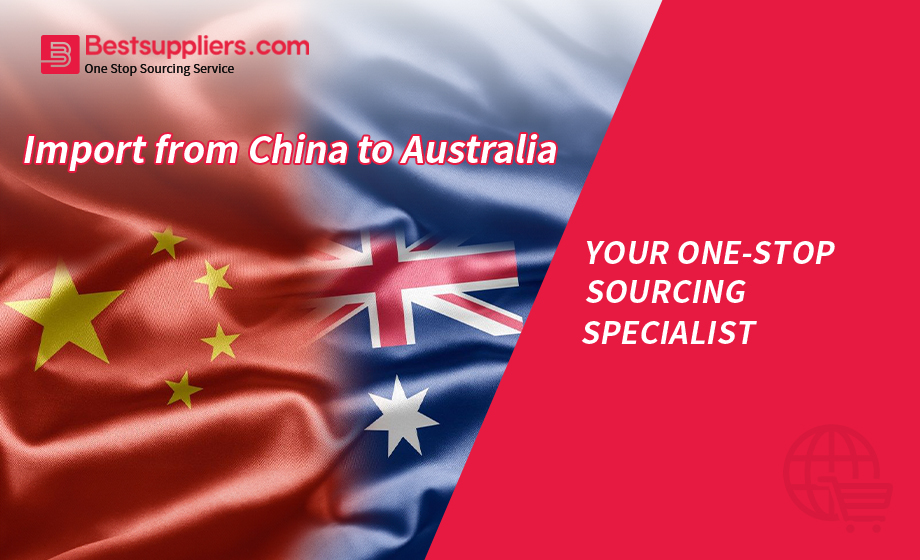Import from China to Australia

Introduction:
The global economy has transformed the landscape of international trade, opening up exciting opportunities for businesses to import goods from various countries. Among the many sourcing destinations, China stands tall as a leading player, offering a wide array of products at competitive prices. Australian entrepreneurs and companies keen on expanding their product offerings can benefit significantly from importing goods from China. However, to embark on this import journey successfully, understanding the intricacies involved is paramount. In this comprehensive guide, we will delve into everything you need to know about importing from China to Australia.
Understand ChAFTA:

ChAFTA, the China-Australia Free Trade Agreement, has been a game-changer for businesses seeking to import from China to Australia. Enacted in December 2015, this landmark trade agreement fosters bilateral trade by eliminating or reducing tariffs on various goods. By tapping into the provisions of ChAFTA, Australian businesses can gain a competitive edge, enhance profitability, and offer a diverse range of products to their customers. To fully leverage the benefits of ChAFTA, it is essential to comprehend the specific tariff reductions and trade preferences that apply to your product categories.
What Type of Product Can You Import from China to Australia?
The Chinese market is vast and diverse, catering to a wide range of product categories that Australian businesses can import. Some of the common types of products that are popularly imported from China to Australia include:
- Electronics: From cutting-edge smartphones and laptops to home appliances and consumer electronics, China offers a rich assortment of electronic products.
- Clothing and Apparel: The Chinese textile and garment industry boasts a vast selection of trendy and cost-effective clothing options for the Australian market.
- Toys and Games: China is a leading producer of toys and games, offering a plethora of options suitable for various age groups and preferences.
- Boats and Watercraft: For maritime enthusiasts and businesses in the marine industry, importing boats from China presents an attractive option.
Australian Product Safety Standards:
Safety is paramount when importing goods into Australia, and adherence to the country's product safety standards is crucial.
These standards are in place to protect consumers from unsafe products and maintain the country's high safety and quality benchmarks. Before importing goods from China, businesses must conduct thorough research to ensure that the products meet all relevant safety standards and regulations. This may involve product testing, certification, and verification from authorized bodies to guarantee the products' safety and compliance.
The AS/NZS standards are set by the joint Australian and New Zealand committee, ensuring that products meet stringent safety and quality benchmarks. As an importer, it is imperative to identify the relevant AS/NZS safety standards that apply to your products. This may involve product testing, certification, and verification from authorized bodies to ensure compliance.
Necessary Documents You Need When Importing Goods from China:
A successful importation process hinges on meticulous documentation. To ensure a smooth customs clearance process, you need to prepare the following essential documents:
- Certificate of Origin: This document certifies the country of origin of the goods and may be necessary for availing preferential tariff rates under ChAFTA.
- Import License: Depending on the type of goods you import, you may need an import license or permit to meet specific regulatory requirements.
- Bill of Lading or Airway Bill: These documents acknowledge the receipt of goods by the shipping carrier for sea and air shipments, respectively.
- Commercial Invoice: This invoice provides detailed information about the goods, their value, and the terms of the sale.
- Proof of Import: Keep a record of all relevant import-related documents for future reference and compliance.
- Packing List: It lists the contents of each package and aids in the customs inspection process.
Importing Tax (duty) from China to Australia:

Importing goods from China to Australia attracts import taxes, commonly known as customs duty. The duty rates vary based on the type of product and its value. To calculate the applicable duty, businesses can refer to the Australian Customs Tariff. Additionally, certain products might be eligible for preferential tariff rates under ChAFTA, leading to reduced duty costs. Proper classification of goods is crucial to determine accurate duty rates and avoid potential customs issues.
When importing goods from China to Australia, various taxes and duties apply. These include:
- Processing Charges: These are fees associated with customs clearance and processing of imported goods. These apply to all Chinese market consignments.
- Goods and Services Tax (GST): Most imported goods attract GST, which is calculated based on the customs value of the goods plus any customs duty and other applicable charges.
- Excise Duty: Some goods, such as alcohol, fuel, and tobacco products, may be subject to excise duty.
- China to Australia Import Duties Rate: The duty rates vary based on the type of product and its value.
- Who can make an import declaration: To tell Australian Customs about the imported items, the importer or an agency could submit an import declaration. The document includes information about the importer, the mode of transportation for the goods, their custom value, and their tariff classification.
- How can I legally reduce the import duty? Strategies to legally minimize import duty costs, such as using free trade agreements or tariff concessions.
- When do I pay GST on imports from China?: Clarifying the timing of GST payment on imported goods.
Australia GST Guide on Imported Goods from China:
Goods and Services Tax (GST) is a critical aspect of importing into Australia. Understanding the following will help importers navigate the GST landscape:
- Goods and Services Tax Rates: The applicable GST rates on different categories of goods. In Australia, imports are subject to a 10% GST. Some goods, including those related to housing, healthcare, wine, and food, are excluded from this tax when they are imported.
- How do I calculate how much GST I need to pay: You can use import duties, product value, shipping insurance, and shipping cost to calculate GST.
- How can I reduce the GST I need to pay?: Legal ways to reduce GST liability, such as using the GST deferral scheme for specific goods.
- When do I pay GST on imports from China? The GST is due when the goods are cleared through Australia’s customs.
Shipping from China to Australia:
Shipping plays a pivotal role in the import process, and choosing the right shipping method is essential. Some key points to consider include:
- Cost for shipping from China to Australia: Factors influencing shipping costs involve import size, value, shipping method, export clearance, freight cost, insurance, port charges, domestic transportation, and so on
- Carrier Services from China to Australia: An overview of various carrier options, including Sea Freight, Air Freight, Rail Freight, and Door-to-Door shipping.
Risks and Problems You May Encounter When Importing Goods:

Importing goods from China is not without its challenges. Some common risks and problems include
- Shipping delays,
- Customs clearance hold-ups,
- Language barriers,
- Cultural differences,
- Supplier Scams,
- High prices /costs,
- Infringing copyright and
- Quality control issues.
It is crucial to conduct thorough due diligence on potential suppliers, establish clear agreements, and maintain open communication to mitigate these risks effectively.
How to Find a Reliable Supplier for Your Import Business:
Finding a trustworthy supplier is vital for a successful import business. Consider these strategies:
- Trade Shows: Attend industry-specific trade shows and exhibitions to connect with potential suppliers.
- Browse Marketplaces Online: Explore online platforms and marketplaces to discover a wide range of suppliers.
- Contact Sourcing Agents: Collaborate with sourcing agents to identify reliable suppliers and conduct supplier background checks.
- Seek recommendations from industry networks.
Thoroughly vetting potential suppliers, conducting factory audits, and requesting product samples can help ensure the supplier's credibility and product quality.
Final Thoughts:
Importing from China to Australia offers tremendous potential for businesses seeking to expand their product offerings and capitalize on cost-effective sourcing. However, it is essential to navigate the complexities of international trade diligently. By understanding ChAFTA, adhering to safety standards, preparing necessary documentation, and navigating import taxes and GST requirements, Australian businesses can embark on a successful importation journey. Additionally, seeking reliable suppliers and proactively addressing potential risks will further enhance the prospects of a flourishing import business. With careful planning and a commitment to compliance, importing from China can be a rewarding and fruitful endeavor.

